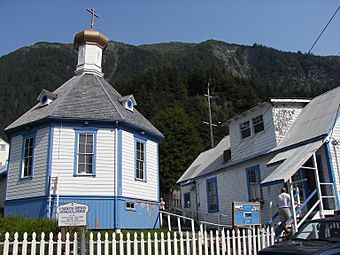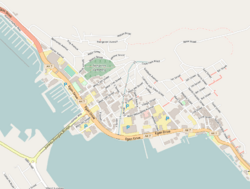St. Nicholas Russian Orthodox Church (Juneau, Alaska) facts for kids
Quick facts for kids |
|
|
St. Nicholas Russian Orthodox Church
|
|
 |
|
| Location | 326 Fifth Street, Juneau, Alaska |
|---|---|
| Area | less than one acre |
| Built | 1893 |
| Website | https://stnicholasjuneau.org/ |
| MPS | Russian Orthodox Church Buildings and Sites TR (AD) |
| NRHP reference No. | 73000377 |
| Added to NRHP | September 19, 1973 |
The St. Nicholas Russian Orthodox Church in Juneau, Alaska, is a special old church built in 1893. It's listed on the National Register of Historic Places, which means it's an important historical building. This church is part of the Orthodox Church in America and has a rich history, especially with the local Tlingit community.
Contents
History of St. Nicholas Church
How the Church Began
Russians didn't settle in Juneau when Alaska was a Russian colony (from 1784 to 1867). The Russian Orthodox Church also didn't send missionaries to Juneau when mining started there in 1881. Instead, the Orthodox Church became strong in Juneau because of local Tlingit leaders.
In 1890, a Tlingit leader named Anathahash traveled to Sitka. There, he was baptized into the Orthodox faith. Many Tlingit people liked the Orthodox Church more than other Christian groups. This was because the Orthodox Church had used local languages in its worship for a long time. They used local languages in Kodiak starting around 1800 and in the Aleutian Islands around 1824.
Tlingit Leaders and Faith
The Holy Scriptures and much of the Divine Liturgy (which is what Orthodox Christians call their main church service) had been translated into the Tlingit language. St. Innocent (Veniaminov) did this work when he was a priest in Sitka (1834–1840) and later as Bishop of Alaska (1842–1850).
Anathahash returned from Sitka in 1890 with Rev. Vladimir Donskoy. He was the first Russian Orthodox priest to hold services in the Juneau area. During his visit, Father Vladimir taught and baptized many local Tlingit people. That year, Alexei Yaakwaan, the son of a Tlingit leader, joined the Orthodox Church. He encouraged his father, Yees Gaanaalx, to be baptized too. Yees Gaanaalx was a leader of the L'eeneidí (Dog Salmon) people from Auke Bay.
A Special Dream and Conversions
On July 26, 1892, Bishop Nicholas (Ziorov) visited Juneau. He was the Bishop of the Aleutian Islands and Alaska from 1891 to 1898. The bishop was met by Tlingit leaders who wanted to become Christian.
According to stories passed down, these Tlingit leaders had all been having the same dream. In their dream, a short, elderly man with a white beard encouraged them to become Christian. When the leaders saw an icon (a religious painting) of Saint Nicholas the Wonderworker, they recognized him as the man from their dreams.
Three days later, a priest named Mitrofan baptized Yees Gaanaalx and his wife. They were given the Christian names Dimitri and Elizabeth. Following their example, about 700 of the 1500 Tlingit people in the area also joined the Orthodox Church.
Building the Church
With so many Native people joining the church, the Orthodox Missionary Society in Russia helped out. They sent architectural drawings and church items like candlestands, a chalice set, and banners. They also sent a full iconostasis (a screen covered with icons) and icons for special holidays. Two hundred silver rubles were sent to help build the church.
The six large panels on the iconostasis are the original icons from Russia. They are special because the doors for the deacon (a church helper) show Sts. Cyril and Methodius. Usually, these doors show Archangels Michael and Gabriel or Deacons Stephen and Lawrence.
The newly baptized Tlingit people and Serbian gold miners, who were already Orthodox, helped build the church. It is a great example of the "Russian Colonial" style of architecture. In June 1894, Bishop Nicholas returned to Juneau. He officially dedicated the new church in honor of Saint Nicholas.
Remembering History
On June 5, 2016, Bishop David (Mahaffey) and Alaska Governor Bill Walker unveiled a monument at St. Nicholas Church. This monument remembers the 881 Aleuts who were forced to move and were held by the United States during World War II.
See also



